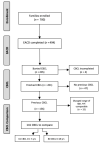Behavioural and Emotional Changes during COVID-19 Lockdown in an Italian Paediatric Population with Neurologic and Psychiatric Disorders
- PMID: 33260987
- PMCID: PMC7760933
- DOI: 10.3390/brainsci10120918
Behavioural and Emotional Changes during COVID-19 Lockdown in an Italian Paediatric Population with Neurologic and Psychiatric Disorders
Abstract
On 11 March 2020, a national lockdown was imposed by the Italian government to contain the spread of COVID19 disease. This is an observational longitudinal study conducted at Fondazione Stella Maris (FSM), Italy to investigate lockdown-related emotional and behavioural changes in paediatric neuropsychiatric population. Families having children (1.5-18 years) with neuropsychiatric disorders referred to FSM have been contacted and proposed to fulfil two online questionnaires (General questionnaire and Child Behaviour Check List (CBCL)) to (i) compare (paired two-sample t-tests) the CBCL scores during lockdown with previous ones, and (ii) investigate the influence (multiple linear regression models) of variables such as age, diagnosis grouping (neurological, neurodevelopmental, emotional, and behavioural disorders) and financial hardship. One hundred and forty-one parents fulfilled the questionnaires. Anxiety and somatic problems increased in 1.5-5 years subpopulation, while obsessive-compulsive, post-traumatic and thought problems increased in 6-18 years subpopulation. In the regression models, younger age in the 1.5-5 years subpopulation resulted as "protective" while financial hardship experienced by families during lockdown was related to psychiatric symptoms increasing in the 6-18 years subpopulation. Some considerations, based on first clinical impressions, are provided in text together with comments in relation to previous and emerging literature on the topic.
Keywords: COVID 19; lockdown; mental health; neurodevelopmental disorders; neurologic disorders; pediatric population; psychiatric disorders.
Conflict of interest statement
The authors declare no conflict of interest.
Figures



References
-
- Caleo G., Duncombe J., Jephcott F., Lokuge K., Mills C., Looijen E., Theoharaki F., Kremer R., Kleijer K., Squire J., et al. The factors affecting household transmission dynamics and community compliance with Ebola control measures: A mixed-methods study in a rural village in Sierra Leone. BMC Public Health. 2018;18 doi: 10.1186/s12889-018-5158-6. - DOI - PMC - PubMed
Grants and funding
LinkOut - more resources
Full Text Sources

